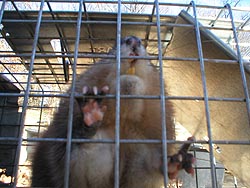|
|
MUSKRAT REMOVAL
Description
 The muskrat is a
stout, chunky animal with short legs. An adult ranges from 22 to 25
inches long. The 11-inch black tail is scaly, practically hairless and
laterally flattened. It is used as a prop when the animal is on its
hind feet and is also an aid to swimming. The average weight of a
mature muskrat is about 2.5 pounds. The large, broad hind feet are
partially webbed and well-adapted for swimming. Muskrats are seldom
found far from water. They prefer the still or slow-moving water of
marshes, ponds and streams. Muskrats are active year-round and, while
usually nocturnal, may move during daylight hours. The muskrat is
primarily a vegetarian, feeding mostly on the roots and stems of
aquatic plants and, if they occur near water, such items as legumes,
grasses, grains, garden crops and apples. Muskrats live in houses
constructed of vegetation or in burrows dug into banks. Both houses and
burrows have underwater entrances and above-water living chambers.
Muskrats breed from early spring until fall, giving birth to several
litters of from four to seven young. The young are born naked and
helpless in protected nest chambers in houses or bank burrows. Young
muskrats grow rapidly and are independent at an early age. The muskrat is a
stout, chunky animal with short legs. An adult ranges from 22 to 25
inches long. The 11-inch black tail is scaly, practically hairless and
laterally flattened. It is used as a prop when the animal is on its
hind feet and is also an aid to swimming. The average weight of a
mature muskrat is about 2.5 pounds. The large, broad hind feet are
partially webbed and well-adapted for swimming. Muskrats are seldom
found far from water. They prefer the still or slow-moving water of
marshes, ponds and streams. Muskrats are active year-round and, while
usually nocturnal, may move during daylight hours. The muskrat is
primarily a vegetarian, feeding mostly on the roots and stems of
aquatic plants and, if they occur near water, such items as legumes,
grasses, grains, garden crops and apples. Muskrats live in houses
constructed of vegetation or in burrows dug into banks. Both houses and
burrows have underwater entrances and above-water living chambers.
Muskrats breed from early spring until fall, giving birth to several
litters of from four to seven young. The young are born naked and
helpless in protected nest chambers in houses or bank burrows. Young
muskrats grow rapidly and are independent at an early age.
Damage
Although Muskrat can be serious agricultural pests, in Minnesota most
of the damage they cause is the tunneling they do to the landscaping
and lawns. Extensive tunneling into earthen dams may result
in
water leaks or even in the loss of stored water. These tunnels create
hazards for lawn mowers, golf carts and will collapse when walked on.
Muskrats have been known to girdle young trees, eat your ornamental
plants and consume your garden produce.
Muskrat
Control
Whether you live on a small pond or have many ponds, Nuisance Bat and Wildlife
Control can handle your muskrat problem. We have the best success when
we can do Muskrat control on the whole pond, so if you have neighbors
that also border the pond its best to work with them in solving your
muskrat problem. If the pond is too big or your neighbors
won’t
cooperate we can also run exclusion wire to prevent the tunneling.
Exclusion
To keep the muskrats from tunneling in your yard we can run exclusion
wire. Nuisance Bat and Wildlife Control will lay the wire flat against the
banks, and fasten it down every few feet to keep it in place. Wire will
extend  from
a foot above to at least three feet below water level.
Since the wire will eventually corrode, this method is not recommended
for ponds where swimming is planned. NBWC can also run rip-rapping with
coarse stone or gravel to prevent muskrats from digging into the banks
or dam slopes of ponds. The material will be applied in a layer about
six inches thick and will extend from one foot above to three feet
below water level. Although this is the most expensive method it will
also protects the pond banks and earthen fill from wave action. from
a foot above to at least three feet below water level.
Since the wire will eventually corrode, this method is not recommended
for ponds where swimming is planned. NBWC can also run rip-rapping with
coarse stone or gravel to prevent muskrats from digging into the banks
or dam slopes of ponds. The material will be applied in a layer about
six inches thick and will extend from one foot above to three feet
below water level. Although this is the most expensive method it will
also protects the pond banks and earthen fill from wave action.
Diseases
Muskrats have been known to carry rabies, intestinal bacteria,
Leptospirosis, and tularemia.
|

